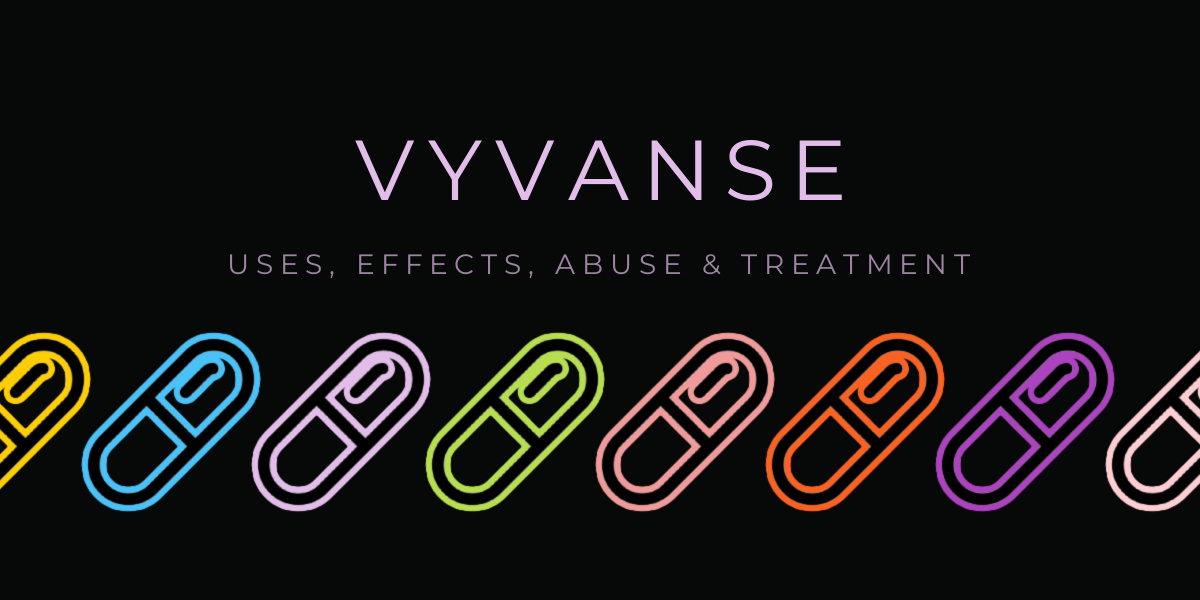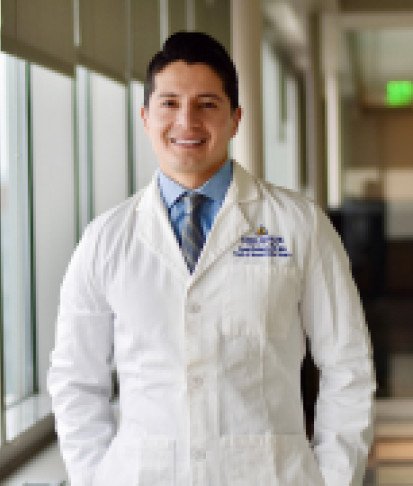Vyvanse (lisdexamfetamine) is a slow-release stimulant currently used to treat ADHD and binge-eating disorders. This guide discusses Vyvanse’s mechanism of action, dosage, abuse side effects, and addiction treatment, comparing it with other well-known brand names used in ADHD management.
- Vyvanse is a stimulant that increases the production of noradrenaline and dopamine.
- The typical initial dosage is 30 mg/day in the morning.
- Vyvanse has high addiction potential, specifically in younger age groups.
- Abuse side-effects include cardiotoxicity (heart problems), hallucinations, and tremors.
- Treatment options include detoxification, individual, and group therapy.

What is Vyvanse?
Vyvanse is the brand name for lisdexamfetamine, a stimulant used for treating attention deficit hyperactivity disorder (ADHD) and binge-eating disorder (BED) in individuals aged six and older. While the therapeutic mechanism is not fully understood, stimulants such as Vyvanse may increase synaptic catecholamine concentrations. Specifically, it leads to an increase in the production and function of noradrenaline and dopamine in the central nervous system.[1][2][3]
The results are improved focus, attention, and impulse control.
Vyvanse is a long-acting medication that provides sustained symptom relief throughout the day due to its gradual metabolism. This extended duration of action is associated with consistent symptom management with minimal sudden peaks and crashes typically associated with shorter-acting stimulants.[4]
Vyvanse dosage
The recommended Vyvanse dosage for patients aged six and above is 30 mg once per day in the morning. If the dosage is insufficient, the healthcare provider may increase it by 10 to 20 mg per week, with a maximum dose of 70 mg/day. The maximum dosage for patients with renal impairment is 50 mg/day.[2]
General recommendations for Vyvanse treatment include taking Vyvanse VS by mouth in the morning, with or without meals. The Food & Drug Administration (FDA) advises patients to avoid afternoon doses that may cause insomnia - a common side effect of this medication. A thorough pre-screening is also advised, as healthcare professionals should evaluate the presence of cardiac disease and the risk of drug abuse.[2]
People who have taken monoamine oxidase inhibitor (MAOI) antidepressants during the past 14 days or have experienced allergic reactions to stimulant drugs may not be able to take Vyvanse.[5]
How is Vyvanse abused?
Vyvanse abuse typically involves taking higher doses or using the medicine differently than the healthcare professional prescribes. Vyvanse abuse is recognized by hazardous use of the substance, compulsive behavior, craving, and continued use regardless of negative effects.[2]
Seeking multiple prescriptions from different doctors, neglecting responsibilities and relationships due to Vyvanse use, and experiencing withdrawal symptoms when attempting to stop are all signs of Vyvanse abuse.
Taking larger doses may be done to enhance the drug’s stimulant effect, for purposes such as enhanced mental focus, improved mood, or accelerated weight loss.[6] Most Vyvanse abuse cases occur in individuals between 18 and 25, with the misuse of stimulants becoming a severe issue on college campuses in the United States and abroad. However, Vyvanse abuse has increased by approximately 67% in the general population.[3]
Vyvanse may also be taken in forms other than the recommended oral route to enhance its stimulant effects. Some individuals may crush Vyvanse tablets into a powder and inhale it, bypassing the intended slow-release mechanism.[2]
Additionally, Vyvanse may be abused with other substances, such as alcohol or other drugs, to enhance its effects or counteract unwanted side effects.
In rare cases, individuals may dissolve Vyvanse in liquid and inject it intravenously. This method of abuse may lead to serious health complications, including infections and the transmission of bloodborne diseases.
Side effects of Vyvanse abuse
The FDA highlights specific side effects of Vyvanse abuse, such as increased heart rate, rapid breathing, high blood pressure, and dilated pupils. Individuals taking high or frequent doses of Vyvanse may also experience excessive sweating, uncontrolled hyperactivity, tremors, loss of coordination, and gastrointestinal issues. Mental health symptoms may include aggression, anxiety, psychosis, as well as suicidal and homicidal ideation.[2][7]
Other studies classify the side effects of Vyvanse abuse into a four-phase sequence, each with distinct symptoms. The first phase of stimulant use is marked by increased euphoria, while the bingeing phase is characterized by mood swings.[7]
In the withdrawal phase, side effects result from a crash in the excessive dopaminergic activity caused by Vyvanse. Individuals may experience dysphoria, anxiety, agitation, increased cravings, fatigue, depression, low energy, and repetitive cycles of binging and crashing.[7]
Additionally, people with chronic stimulant use might develop heightened tolerance to its effects, thus requiring higher doses. Common side effects include gastrointestinal issues and cardiotoxicity (heart problems).[7]
The FDA also highlights specific safety concerns associated with prolonged Vyvanse use. These may include severe heart problems or defects and psychiatric events, such as increased aggression, hallucinations, mania, and psychosis.[1]
Is Vyvanse addictive?
Vyvanse VS has a high potential of becoming addictive because it creates euphoria - a feeling of excitement or happiness. Other effects that individuals may find pleasurable include increased mental focus and motivation, reinforcing the desire to continue using the medication.[7][8]
The diminishing pleasurable effects of Vyvanse associated with long-term use may lead some individuals to continue seeking the initial euphoric feeling. As a result, users may take Vyvanse more frequently or in larger doses, increasing the risk of addiction.[7][8]
With prolonged use, the body can develop tolerance to Vyvanse. This means that individuals may need higher doses to achieve the desired effects.[7][8]
Vyvanse vs. Adderall
Vyvanse and Adderall are central nervous system stimulants used for treating ADHD, but Adderall is made of amphetamine salts.[9] The two medications have distinct immediate and long-term effects and different dosages.
| Adderall | Vyvanse | |
| Dosage | 5-60 mg/day | 30-70 mg/day |
| Immediate effects | Sleep problemsDecreased appetite | Decreased appetiteWeight lossInsomniaNausea |
| Long-term effects | Inhibits proper production of serotonin, dopamine, and norepinephrineParkinson’s diseaseMemory problemsVerbal learning difficulties | Delayed growth in children and teenagers |
| Risk of overdose | FaintingFeverSeizureHeart attack | Elevated heart rateIncreased blood pressureIncreased sweatingAggressionTremors |
| Addictive (Y/N) | Yes | No |
Vyvanse vs. Ritalin
Both Ritalin and Vyvanse contain distinct stimulant substances used for treating ADHD. Ritalin contains methylphenidate, whereas the primary substance in Vyvanse is lisdexamfetamine.[10]
| Ritalin | Vyvanse | |
| Dosage | 20-30 mg/day | 30-70 mg/day |
| Immediate effects | AgitationHeadacheSleep problemsDecreased appetiteStomach pain | Decreased appetiteWeight lossInsomniaNausea |
| Long-term effects | Poor circulationDelayed growth in childrenPotential for abuse | Delayed growth in children and teenagers |
| Risk of overdose | DelusionShakinessParanoiaAnxietySeizureConfusion | Elevated heart rateIncreased blood pressureIncreased sweatingAggressionTremors |
| Addictive (Y/N) | Yes | No |
Vyvanse vs. Concerta
Like Ritalin, Concerta is a different brand name using methylphenidate, and it is also used as an ADHD treatment.
| Concerta | Vyvanse | |
| Dosage | 18-72 mg/day | 30-70 mg/day |
| Immediate effects | Sleep problemsDecreased appetiteStomach pain | Decreased appetiteWeight lossInsomniaNausea |
| Long-term effects | Lasting psychosisSevere heart problemsAddictionImpacted decision-making | Delayed growth in children and teenagers |
| Risk of overdose | AnxietyRacing heartVisual or auditory hallucinationsPsychosisManic episodes | Elevated heart rateIncreased blood pressureIncreased sweatingAggressionTremors |
| Addictive (Y/N) | Yes | No |
Treatment for Vyvanse addiction
The first stage of Vyvanse addiction treatment may require detoxification under medical supervision to manage withdrawal symptoms.
Various behavioral therapies may be effective after detoxification, helping individuals modify unhealthy thoughts, behaviors, and patterns associated with drug use. Cognitive-Behavioral Therapy (CBT) and one-on-one counseling are common approaches.[11]
Support groups may also be effective, as they offer connections with peers experiencing similar addictions. Sharing stories, challenges, and successes in a supportive environment may provide encouragement and a sense of community.
If an individual has co-occurring mental health disorders along with Vyvanse addiction - for example, depression or anxiety - integrated dual diagnosis treatment may be required. This addresses both conditions simultaneously and improves recovery chances.


-guide-detail.jpg?v=1722501856)

-guide-detail.jpg?v=1743497813)